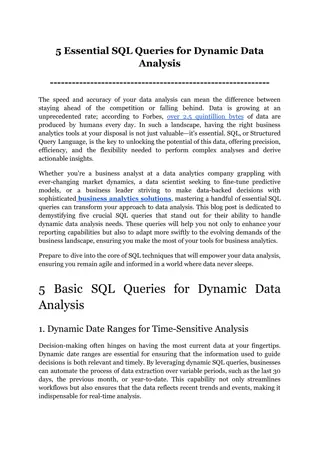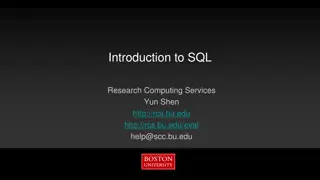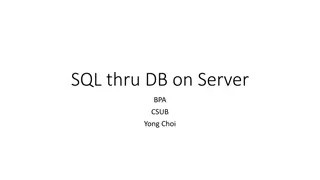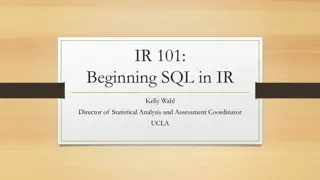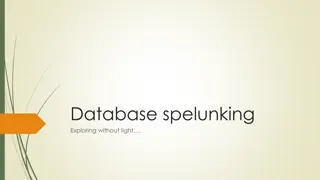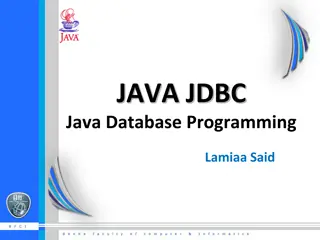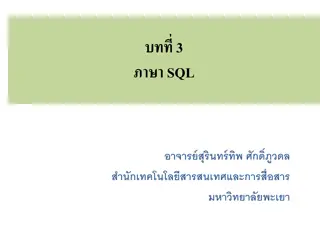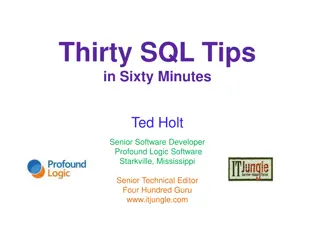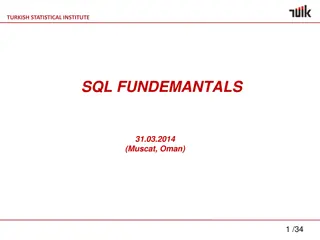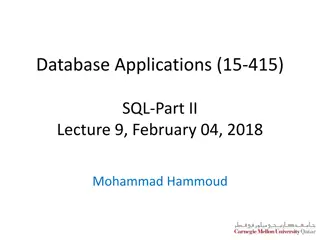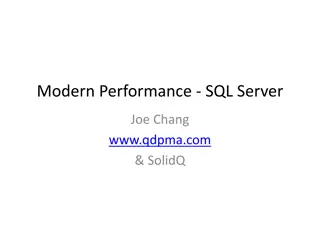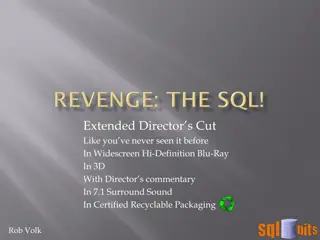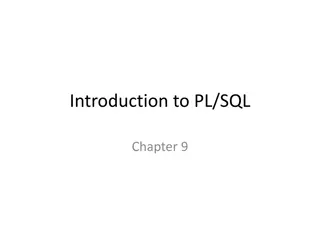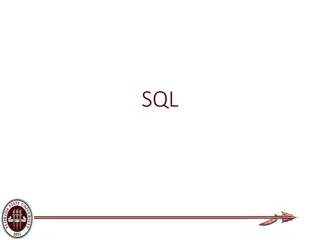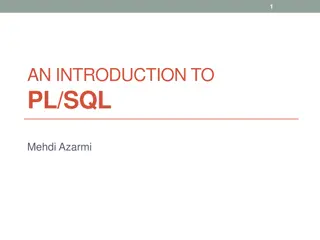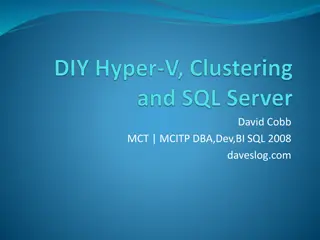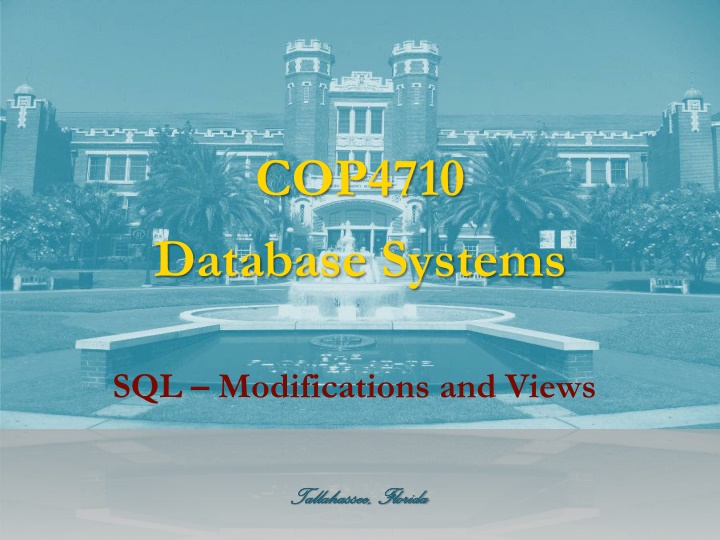
Database System SQL Modifications and Views in Tallahassee, Florida
Learn about SQL modifications including inserting, updating, and deleting tuples in a database system. Explore examples of insertion, specifying attributes, inserting many tuples, and deletion commands in SQL. Discover how to efficiently modify a database using SQL queries in the context of Tallahassee, Florida.
Download Presentation

Please find below an Image/Link to download the presentation.
The content on the website is provided AS IS for your information and personal use only. It may not be sold, licensed, or shared on other websites without obtaining consent from the author. If you encounter any issues during the download, it is possible that the publisher has removed the file from their server.
You are allowed to download the files provided on this website for personal or commercial use, subject to the condition that they are used lawfully. All files are the property of their respective owners.
The content on the website is provided AS IS for your information and personal use only. It may not be sold, licensed, or shared on other websites without obtaining consent from the author.
E N D
Presentation Transcript
COP4710 Database Systems SQL Modifications and Views Tallahassee, Florida Tallahassee, Florida
Modifications A modification command does NOT return a result as a query does, but it changes the database in some way There are three kinds of modifications: 1. Insert a tuple or tuples 2. Delete a tuple or tuples 3. Update the value(s) of an existing tuple or tuples 1
Insertion To insert a single tuple: INSERT INTO <relation> VALUES ( <list of values> ); Example: add to Likes(drinker, beer) the fact that Sally likes Bud: INSERT INTO Likes VALUES( Sally , Bud ); 2
Specifying Attributes in INSERT We may add to the relation a list of attributes There are two reasons to do so: 1. We forget the standard order of attributes for the relation We don t have values for all attributes, and we want the system to fill in missing components with NULL or default values Another way to add the fact that Sally likes Bud to Likes(drinker, beer): 2. INSERT INTO Likes(beer, drinker) VALUES( Bud , Sally ); 3
Inserting Many Tuples We may insert the entire result of a query into a relation, using the form: INSERT INTO <relation> ( <subquery> ); INSERT INTO Beers(name) (SELECT beer from Sells); E.g., 4
Example: Insert a Subquery Using Frequents(drinker, bar), enter into the new relation PotBuddies (name) all of Sally s potential buddies, i.e., those drinkers who frequent at least one bar that Sally also frequents Pairs of Drinker tuples where the first is for Sally, the second is for someone else, and the bars are the same The other drinker INSERT INTO PotBuddies (SELECT d2.drinker FROM Frequents d1, Frequents d2 WHERE d1.drinker = Sally AND d2.drinker <> Sally AND d1.bar = d2.bar ); 5
Deletion To delete tuples satisfying a condition from some relation: DELETE FROM <relation> WHERE <condition>; Example: Delete from Likes(drinker, beer) the fact that Sally likes Bud: DELETE FROM Likes WHERE drinker = Sally AND beer = Bud ; 6
Delete all Tuples Make the relation Likes empty: DELETE FROM Likes; Note no WHERE clause needed 7
Delete Many Tuples Delete from Beers(name, manf) all beers for which there is another beer by the same manufacturer. DELETE FROM Beers b WHERE EXISTS ( SELECT name FROM Beers a WHERE a.manf = b.manf AND a.name <> b.name ); Beers with the same manufacturer and a different name from the name of the beer represented by tuple b 8
Semantics of Deletion Suppose Busch makes only Bud and Bud Lite, and suppose we come to the tuple b for Bud first The subquery is nonempty, because of the Bud Lite tuple, so we delete Bud Now, When b is the tuple for Bud Lite, do we delete that tuple too? The answer is that we do delete Bud Lite as well. The reason is that deletion proceeds in two stages: 1. Mark all tuples for which the WHERE condition is satisfied in the original relation 2. Delete the marked tuples 9
Updates To change certain attributes in certain tuples of a relation: UPDATE <relation> SET <list of attribute assignments> WHERE <condition on tuples>; Example: Change drinker Fred s phone number to 555- 1212: UPDATE Drinkers SET phone = 555-1212 WHERE name = Fred ; 10
Update Several Tuples Increase price that is cheap: UPDATE Sells SET price = price * 1.07 WHERE price < 3.0; 11
Views A view is a virtual table , a relation that is defined in terms of the contents of other tables and views Declare by: CREATE VIEW <name> AS <query>; In contrast, a relation whose value is really stored in the database is called a base table 12
Example: View Definition CanDrink (drinker, beer) is a view containing the drinker-beer pairs such that the drinker frequents at least one bar that serves the beer: CREATE VIEW CanDrink AS SELECT drinker, beer FROM Frequents, Sells WHERE Frequents.bar = Sells.bar; 13
Example: Accessing a View You may query a view as if it were a base table There is a limited ability to modify views if the modification makes sense as a modification of the underlying base table Example: SELECT beer FROM CanDrink WHERE drinker = Sally ; 14
What Happens When a View Is Used? The DBMS starts by interpreting the query as if the view were a base table Typical DBMS turns the query into something like relational algebra The queries defining any views used by the query are also replaced by their algebraic equivalents, and spliced into the expression tree for the query 15
Example: View Expansion PROJbeer SELECTdrinker= Sally CanDrink PROJdrinker, beer JOINFrequents.bar = Sells.bar Frequents Sells 16


